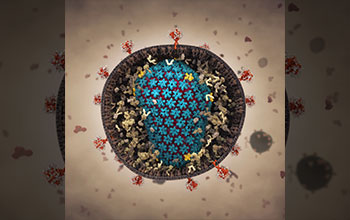Multimedia Gallery
Simulation shows HIV capsid interacting with its environment
The genetic material of the HIV virus is encased in multiple structures that hide it from the host immune system. The capsid, in blue, protects the virus after it enters a cell and shuttles it to the nucleus, where it completes the process of infection.
More about this image
A simulation created on a supercomputer of 1.2 microseconds in the life of the HIV capsid, a protein cage that shuttles the HIV virus to the nucleus of a human cell, has been created by researchers from the University of Illinois (U of I). The 64-million-atom simulation offers new insights into how the virus senses its environment and completes its infective cycle.
The capsid simulation was performed on the Department of Energy's Titan supercomputer and analyses of the data was performed on the Blue Waters supercomputer at the National Center for Supercomputing Applications at the U of I.
"We are learning the details of the HIV capsid system, not just the structure but also how it changes its environment and responds to its environment," said Juan R. Perilla, a U of I research scientist who led the study with U of I physics professor Klaus Schulten, who passed away in October 2016. Such details could help scientists find new ways to defeat the virus, Perilla said.
Perilla said data gathered from the study reveal potential vulnerabilities that could be exploited to develop new drugs to defeat the HIV virus by targeting its capsid.
The research was supported in part by the National Science Foundation (grants OAC 07-25070 and OAC 12-38993).
To learn more about this research, see the NSF News From the Field story Massive simulation shows HIV capsid interacting with its environment. (Date image taken: 2016-17; date originally posted to NSF Multimedia Gallery: Dec. 7, 2017)
Credit: Juan R. Perilla and Klaus Schulten, University of Illinois at Urbana-Champaign
Images and other media in the National Science Foundation Multimedia Gallery are available for use in print and electronic material by NSF employees, members of the media, university staff, teachers and the general public. All media in the gallery are intended for personal, educational and nonprofit/non-commercial use only.
Images credited to the National Science Foundation, a federal agency, are in the public domain. The images were created by employees of the United States Government as part of their official duties or prepared by contractors as "works for hire" for NSF. You may freely use NSF-credited images and, at your discretion, credit NSF with a "Courtesy: National Science Foundation" notation.
Additional information about general usage can be found in Conditions.
Also Available:
Download the high-resolution JPG version of the image. (1.2 MB)
Use your mouse to right-click (Mac users may need to Ctrl-click) the link above and choose the option that will save the file or target to your computer.

